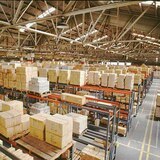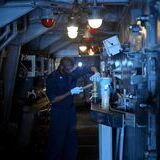Productivity and Order: Dynamic Shelving for Lean Manufacturing
Introduction to dynamic shelving for production lines
In this post we are going to talk about dynamic racks applied to components feeding for production lines.
These racks use gravity to facilitate the displacement of the components using systems such as rollers or balls. In this way the material is fed on one side and consumed on the other side of the rack thus facilitating FIFO (First In First Out) and avoiding interference between logistics personnel and production personnel.
Let's illustrate this with two examples:
- In this first example below, the operator would be positioned on the "Outgoing Material for Line Consumption" side and the logistician on the "Feeding Material to the Line" side. The logistician goes to the warehouse to pick up material and feeds that material to the rack.The operator will consume the material and the empty boxes will be left at the bottom and will fall by gravity to be picked up by the line logistician. In this way there will be no interference between the two.
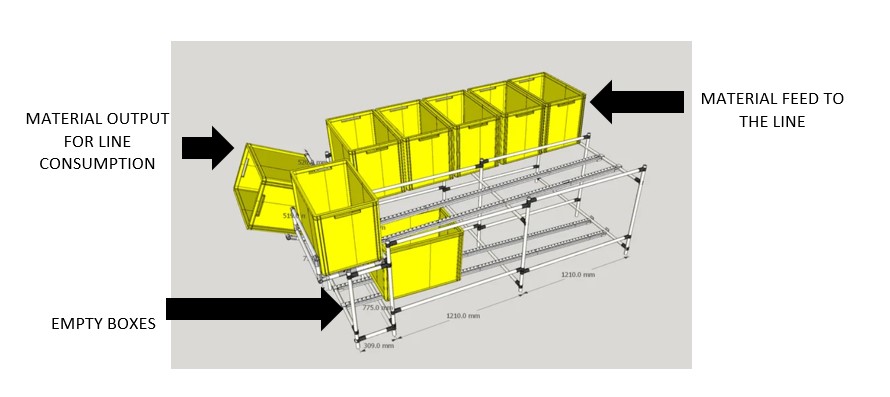
- In this second example we show the profile of another rack containing 4 different products.The operation would be the same as the previous one, the logistician feeding from "Feeding Material to Line" and the operator consuming the material on the other side, but in this case he would leave the boxes on the top that would fall by gravity.Here, as you can see, there will be no interference between the operator and the logistic person.
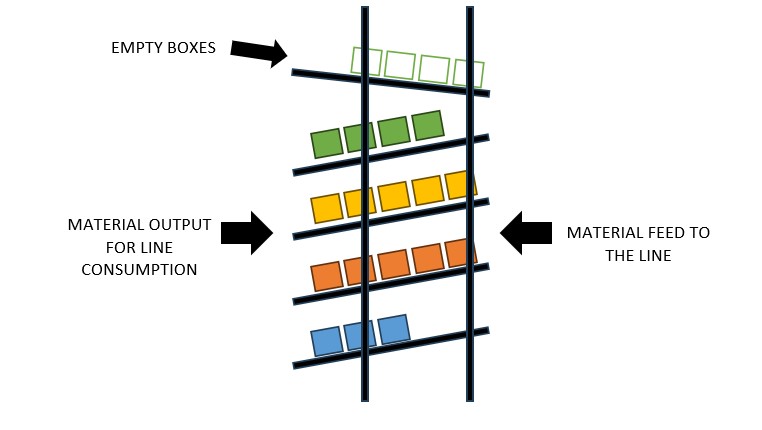
In this link, we can see a video of another example.
Benefits of Dynamic Racking in Production Lineas
- Facilitates the feeding of components to the line: since, as mentioned above, the person in charge of supplying material to the line will not interfere with the operator, because they will be on different sides of the rack.
- Improved workflow and waste reduction: Related to the above point, on the one hand, as there is no interference between workers, waste is reduced. In addition to this, the movements and movements required by the operator will be reduced because the boxes of components will fall by gravity instead of having to go for them. The management of consumed component boxes will also be much easier because they will also fall by gravity.
- Improved layout and space utilization: By allowing the storage of components and empty boxes in the same square meters, space utilization will be optimized.
- Facilitates FIFO tracking: If the line material supply personnel do the feeding correctly, the operators who provide direct value on the production line will follow the FIFO without any problem.
- They are flexible and easily adjustable: Live shelves are easily adjusted and reconfigured, adapting to changes in production requirements or product lines, allowing agile responses to demand and production processes.
- Increased safety: Having a better and more orderly layout reduces the risk of accidents due to "tripping" with boxes, material in between, etc.
- Better visual management: With dynamic racks it is very easy to see the needs of components in the line to avoid stoppages due to lack of food.
Some Design Considerations for Dynamic Racking in Lean Manufacturing
When contacting the supplier that will provide the flow racking, you will have to take into account the following so that they can take it into account in their design:
- Racks should always be designed to promote a continuous flow of materials: The objective of these racks will always be to reduce the waiting time between the receipt of components and their use on the production line. By introducing the components on the opposite side of the production line, this is facilitated.
- Ergonomic studies should be carried out to facilitate accessibility to the components to be assembled on the line: The most frequently used elements should be at an accessible height and the openings should be designed to minimize the need to bend, stretch or lift heavy objects.
- Adjustability and flexibility: When choosing the flow rack, its adjustability in case of production needs or layout changes should be taken into account. This includes the possibility of adjusting the height of the shelves, changing the arrangement of materials, adding or removing sections...
- Adequate Visual Management: this is important so that workers can clearly identify the components to be used. Live shelving should have a labeling facility to facilitate this visual identification.
- Maintenance and cleaning: The design of the shelving must facilitate easy and regular maintenance and cleaning to prolong the life of the shelving. The materials chosen for the shelving structure should be durable, as well as easily replaceable in case of wear and tear.
- Evaluate the load capacity: Make sure the shelving system you choose can handle the load capacity of your products safely and efficiently. This is crucial to maintaining structural integrity and safety in the workplace.
How to Choose the Right Drive-in Racking System for Your Lean Operation
In addition to design considerations, we list here everything you need to keep in mind when choosing the perfect shelving for your line needs:
- Realiza el ejercicio de comprensión de tus necesidades específicas: Aquí debes detenerte a considerar el tipo de producto que manejas, sus dimensiones, la frecuencia de rotación que tiene, así como los requisitos de acceso rápido del material.
- Evalúa tu espacio disponible: Con un plano de tu layout de línea de producción puedes evaluar la superficie que tienes disponible, para poder determinar el tamaño y cantidad de estanterías dinámicas que puedes poner, así como su disposición más eficiente.
- En caso de duda consulta a expertos: La estantería ideal puede hacer que tu operativa en la línea sea mucho más eficiente, por ello si tienes dudas, consulta a expertos en logística o proveedores especializados en este tipo de sistemas.
- Perform the exercise of understanding your specific needs: Here you should stop to consider the type of product you handle, its dimensions, the frequency of rotation it has, as well as the requirements for quick access to the material
- Evaluate your available space: With a plan of your production line layout you can evaluate the surface area you have available, in order to determine the size and number of live racks you can place, as well as their most efficient layout.
- If in doubt, consult experts: The ideal rack can make your line operation much more efficient, so if you have any doubts, consult logistics experts or suppliers specialized in this type of system.
Case Study Example to understand the Implementation of Dynamic Racks
Let's imagine a workstation or station where the value-added operation is to route a cable on a piece of plastic. The cables are in plastic boxes that come from the supplier and there are 4 cables per box.
First condition: Cable boxes located in Conventional Racks
Having a conventional shelf, the layout would be as follows:
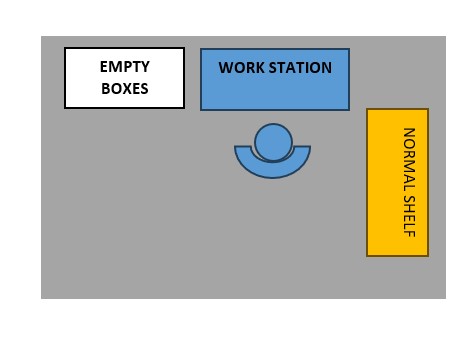
In this case the operation of the worker's cycle would be summarized as follows:
- Operator goes to the rack to get cable.
- He takes cable from the box and goes with it to the work station.
- Routes the cable
- He picks up part with routed cable and moves it to a buffer between stations.
- Moves to the next part also located in a buffer.
- Picks up the part and deposits it in the work station.
Let's imagine that this normal cycle takes 50 seconds.
Every 4 cables consumed, the box is finished and the worker must move to leave the box in a dedicated place for empty boxes to facilitate this management to the person in charge of logistics. We describe the operation corresponding to the fourth cable:
- Operator goes to the shelf to get cable.
- He picks up empty box with cable and brings the next box closer.
- Moves to the empty box area and deposits the box.
- He goes with the cable from the empty box area to the work table.
- Routes the cable
- Picks up part with routed cable and moves it to a buffer between stations.
- Moves to the next piece also located in a buffer.
- Picks up the part and deposits it in the workstation.
Assume this cycle would take about 70 seconds.
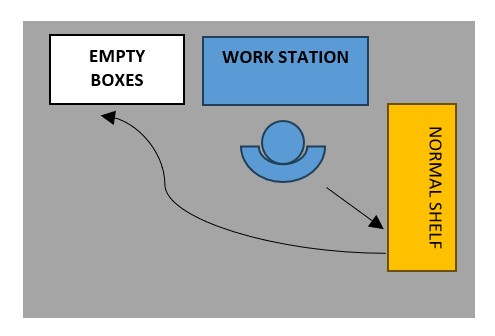
Second condition: Cable boxes located in Dynamic Racks
With a flow rack the layout would be as follows, which as you can see no longer has the empty box area since the operator would leave them in the same rack that would fall by gravity to the other side as shown in the first point "Introduction to Flow Racking for Production Lines".
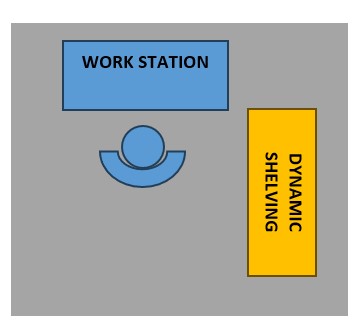
The standard operation before having to change the box would be the same as in the previous case:
- Operator goes to dynamic rack to get cable.
- He takes cable from the box and goes with it to the workstation.
- Routes the cable
- He picks up part with routed cable and moves it to a buffer between stations.
- Moves to the next part also located in a buffer.
- Picks up the part and deposits it in the work station.
However, every 4 wires consumed, it does change things, because when the box is finished, the operator simply takes it out and puts it in the bottom area of the rack that will fall by gravity on the other side of the line (where the logistician works) and the new box will fall by gravity, he will not need to bring it closer. We describe the operation corresponding to the fourth cable:
- Operator goes to the rack to get cable.
- He picks up the cable from the empty box, deposits the box in the bottom area (empty boxes) of the flow rack and goes with it to the workstation.
- Routes the cable
- Picks up part with routed cable and moves it to a buffer between stations.
- Moves to the next part also located in a buffer.
- It picks up the part and deposits it in the work station.
As we can see, with respect to the standard cycle, here it only performs the operation of leaving the box in the bottom zone. Let's imagine that this operation takes 5 seconds more, so it would be 55 seconds in total.
If we compare the layout with conventional racking and the dynamics taking into account the acyclic elements of when the box is finished, we will have the following:
- Cycle time Conventional racking = (50 + 50 + 50 + 50 + 70) / 4 = 55 sec/item
- Cycle time Dynamic racking = (50 + 50 + 50 + 50 + 55) / 4 = 51.25 sec/part
The gain in cycle time with dynamic racking is more than 7%, something to take into account to increase productivity in a factory.
In addition to this, the possible interferences that the logistician could have feeding material to the conventional rack and picking empty boxes have not been taken into account for the calculation. These interferences would not occur at all in the case of live racking.
Kanban and dynamic shelving in a production line
In dynamic shelves it is quite simple to implement a pull system through Kanban cards (see post Introduction to Kanban Systems). It would be done as follows:
- The boxes containing the products would have a Kanban card attached to them indicating what each box contains.
- As the production line consumes components from a given box, when it finishes, it would place the box in the empty box area and remove the card to place it in a storage locker.
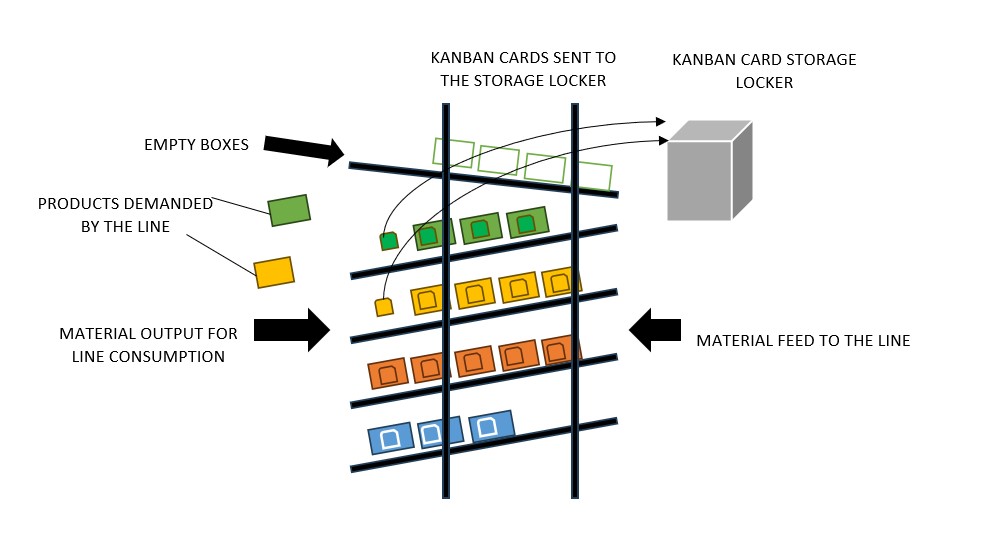
- The logistic operator would take the Kanban cards that would authorize him to go to the warehouse to pick up the material.
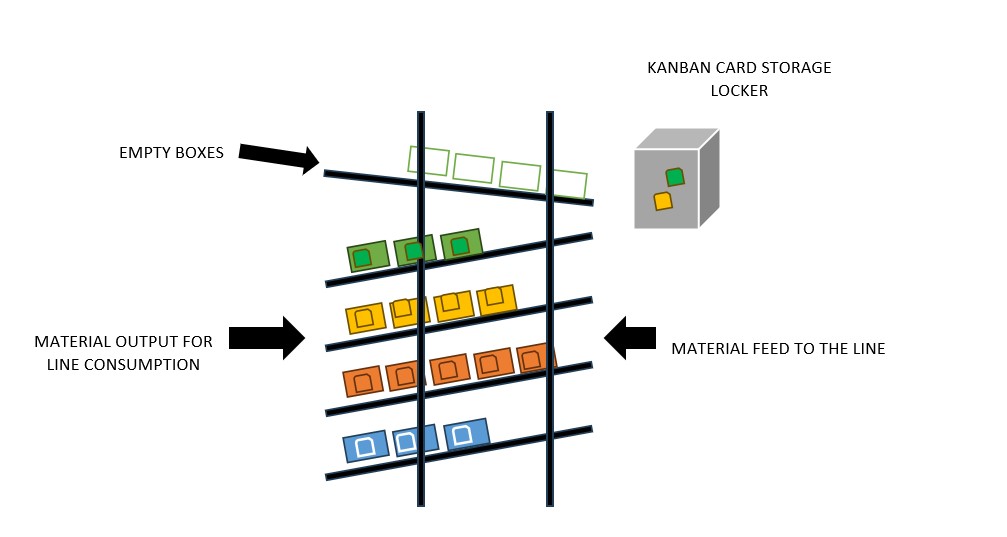
In this way, only what has been consumed will be replenished, "supermarket style".
Maintenance and Safety in Dynamic Racking for Lean Manufacturing
In order to ensure efficient and safe operation, the following points should be checked frequently in all dynamic racks:
- Visual inspection of the rack, focusing on the areas where most movement and friction occur.
- Check the roller system: make sure that they are correctly aligned and that there are no seized rollers, since they could increase friction, causing inefficiencies when moving the material or increasing the risk of accidents.
- Cleanliness: it is necessary to eliminate accumulations of loose material, dust, debris, etc. that may interfere with the correct movement of materials in the rack.
- Checking of braking systems: This is quite important because a defective braking system will cause damage to products and/or workers.
All maintenance interventions should be recorded in order to have data when purchasing new racks in the future.





